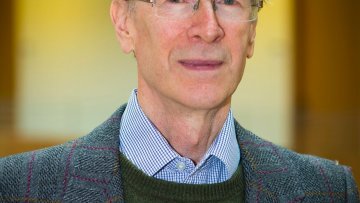Arithmetic and Dynamics on Markoff-Hurwitz Varieties
Abstract
Markoff triples are integer solutions of the equation $x^2+y^2+z^2=3xyz$ which arose in Markoff's spectacular and fundamental work (1879) on diophantine approximation and has been henceforth ubiquitous in a tremendous variety of different fields in mathematics and beyond. After reviewing some of these, we will discuss joint work with Bourgain and Sarnak on the connectedness of the set of solutions of the Markoff equation modulo primes under the action of the group generated by Vieta involutions, showing, in particular, that for almost all primes the induced graph is connected. Similar results for composite moduli enable us to establish certain new arithmetical properties of Markoff numbers, for instance the fact that almost all of them are composite.
Time permitting, we will also discuss recent joint work with Magee and Ronan on the asymptotic formula for integer points on Markoff-Hurwitz surfaces $x_1^2+x_2^2 + \dots + x_n^2 = x_1 x_2 \dots x_n$, giving an interpretation for the exponent of growth in terms of certain conformal measure on the projective space.
QI rigidity of commensurator subgroups
Abstract
One of the main themes in geometric group theory is Gromov's program to classify finitely generated groups up to quasi-isometry. We show that under certain situations, a quasi-isometry preserves commensurator subgroups. We will focus on the case where a finitely generated group G contains a coarse PD_n subgroup H such that G=Comm(H). Such groups can be thought of as coarse fibrations whose fibres are cosets of H; quasi-isometries of G coarsely preserve these fibres. This generalises work of Whyte and Mosher--Sageev--Whyte.
Even a tiny cosmological constant casts a long shadow
Abstract
Over 50 years ago, Bondi, Sachs, Newman, Penrose and others laid down foundations for the theory of gravitational waves in full non-linear general relativity. In particular, numerical simulations of binary mergers used in the recent discovery of gravitational waves are based on this theory. However, over the last 2-3 decades, observations have also revealed that the universe is accelerating in a manner consistent with the presence of a positive cosmological constant $\Lambda$. Surprisingly, it turns out that even the basic notions of the prevailing theory of gravitational waves --the Bondi news, the radiation field, the Bondi-Sachs 4-momentum-- do not easily generalize to this context, {\it no matter how small $\Lambda$ is.} Even in the weak field limit, it took a hundred years to find an appropriate generalization of Einstein's celebrated quadrupole formula to accommodate a positive cosmological constant. I will summarize the main issues and then sketch the current state of the art.
11:00
Goursat rank 4 rigid local systems
Abstract
In the late 1880's Goursat investigated what we now call rigid local systems, classically described as linear differential equations without accessory parameters. In this talk I will discuss some arithmetic and geometric aspects of certain particular cases of Goursat's in rank four. For example, I will discuss what are likely to be all cases where the monodromy group is finite. This is joint work with Danylo Radchenko.
Oxford mathematician Sir Andrew Wiles, renowned for his proof of Fermat’s Last Theorem, has been appointed by Her Majesty the Queen to be Oxford’s first Regius Professor of Mathematics.
The Regius Professorship – a rare, sovereign-granted title – was granted to Oxford’s Mathematical Institute as part of the Queen’s 90th birthday celebrations. It is the first Regius Professorship awarded to Oxford since 1842.



